Mahanidhi Madan Gopal Das
The following question was recently posed by one Brahmin:
“What is the difference between formally accepting diksa from a Guru, and just accepting a Guru within one’s heart and following their teachings?”
Bhagavan Sri Ramacandra, Sri Krishna, Sri Caitanya Mahaprabhu, the 6 Gosvamis, and all Vaisnava and Advaitan acaryas have personally showed the example by formally accepting diksa from Sri Guru. The Srutis, Upanisads, Gita, Srimad Bhagavatam, Ramayana, Mahabharata, and Sri Guru Grantha all proclaim the absolute need to accept diksa from a living Guru.
Sri Sanatana Goswami quotes many Puranas in Hari Bhakti Vilasa stating that humans devoid of diksa attain animal births in the next life, pasu yoni janam.
Instructing Sri Sanatana Goswami on the absolute necessity and power of formal mantra diksa from a living Sri Guru, Sri Caitanya Mahaprabhu said:
dīkṣā-kāle -kare – bhakta, – ātma-samarpaṇa
sei-kāle -kṛṣṇa tare, karena- ātma-sama
sei- deha –karena- tāra, cid-ānanda-maya
aprākṛta-dehe- tāṅra , caraṇa- bhajaya
“At the time of diksa, the bhakta personally offers himself to Sri Krishna i.e thru His representative, Sri Guru. Bhagavan Sri Krishna then makes the devotee equal to Himself by transforming the devotee’s body into one of spiritual bliss (cid –ananda- maya- deha). In that transcendent body, the devotee then worships Sri Krishna’s lotus feet.” (Sri Caitanya Caritamrita 3. 4.192-193)
One cannot avoid the sastric principle and traditional practice of surrendering to Sri Guru just by mentally accepting a Guru within one’s heart. This is not diksa, and thus no sambandha or eternal relationship with either Sri Guru or Sri Krishna can be established in this way.
Although they may be comforting in some situations—personal projections, speculations, sentiments, imaginations, and dream realities will not bring anyone spiritual perfection. Only accepting a Guru in the mind will be as fruitful as mentally accepting a woman to be your wife, and expecting that mentality to give you happiness, fulfilment, and children.
Bhagavan Sri Krishna says in Bhagavat Gita (16.24):
yaḥ- śāstra-vidhim -utsṛjya, vartate- kāma-kārataḥ
na –sa- siddhim -avāpnoti, na -sukhaṁ –na- parāṁ -gatim
“One who neglects or rejects the rules and laws of sastra, and whimsically just follows one’s mind and heart will NOT ATTAIN ANY spiritual perfection, happiness or liberation, mukti or moksa.”
Sri Baladeva Vidyabhusana tika: He who acts according to his own preferences (kāma-kārataḥ), and does not follow prescribed actions, and actually does what is forbidden by scripture, will not attain purification of heart (siddhim), necessary for attaining the goal of life. What then to speak of attaining peace (sukham) or liberation (parāṁ- gatim)?
After telling the plight of the independent whimsical one who rejects scripture, Sri Krishna emphasizes the importance of accepting and following sastra for all human beings in Bhagavad Gita (16.24).
tasmāc- chāstraṁ- pramāṇaṁ -te, kāryā-kārya-vyavasthitau
jnātvā śāstra-vidhān-oktaṁ , karma –kartum- ihārhasi
Sri Krishna says, “O Arjuna! Therefore, the scripture is your authority in the matter of determining what is to be done and what is not to be done. Understanding the scriptural injunctions, you should act accordingly in this world.”
All personal relationships begin with internal acceptance. Without first accepting someone within one’s mind and heart, there is no chance for any future physical relationship in a life of mutual love and dedication. Thus the acceptance of a Guru in one’s mind and heart is good because it signifies the beginning of one’s spiritual life.
However, to be fruitful, one’s inner acceptance of Guru must lead to external surrender and taking formal diksa from Sri Guru. By the diksa process one will then genuinely feel the direct presence of both Sri Guru and Sri Krishna within one’s surrendered heart.
It will no longer be an imaginary Guru/sisya relationship within one’s mind. One will experience a living, tangible, perceivable, and most fulfilling personal relationship with both Govindadeva and one’s beloved Gurudeva.
In Srimad Bhagavatam (9.4.68), Sri Krishna describes the intimate loving connection between Himself and the saranagati jiva, surrendered soul.
sādhavo- hṛdayaṁ- mahyaṁ, sādhūnāṁ- hṛdayaṁ -tv -aham
mad-anyat -te –na- jānanti, nāhaṁ -tebhyo –manāg api
Bhagavan Sri Krishna said, “O Rishi Durvasa! The saintly devotee is always within the core of My heart, and I am always in the heart of My devotee. My devotees know nothing but Me, and I know nothing but them.”
By surrendering and taking diksa from Sri Guru, Bhagavan Sri Krishna will personally manifest in your heart and guide you clearly and correctly. Otherwise, your “mental Guru concept” will fail because it has no backing from sastra, sadhu or Guru.
The following explanation by Pandit Sri Ananta Das Babaji Maharaja perfectly underscores the absolute need for humans to take diksa from a qualified Guru.
“Some people, even after learning of the importance of dīkṣā, think there is no need for them to acquire it. They believe that just by chanting harināma, everything is accomplished. For those who have been somehow harmed or deceived in spiritual matters, that is a natural attitude.
“But this is not the opinion of the Gosvāmīs. Even though observing that in the śāstras and the writings of the mahājanas that dīkṣā is described as a necessity, and seeing that great devotees, past and present, have followed this virtuous practice, some people are still averse to accepting the shelter of a sad-guru.
“The chanting of Hare Krishna maha-mantra by this type of person only results in nāma-aparādha (offense to the Holy Name). They are ignoring both the śāstras and the statements of the mahājanas, and also offending the principle of guru-tattva—all of which are serious offenses.” (Guru Tattva Vijnana)
Guru Sisya Prema Sambandha ki jai! Guru diksa ki jai! Jai Jai Sri Radhe!


